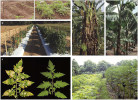Co nám přináší výzkum interakce rostlin s patogeny?
- Autor: Martin Janda
- Vyšlo v časopise Živa 1/2020 na straně 10
Usmrtit je, či nechat kolonizovat? To je otázka, kterou rostlině pomáhá řešit její imunita v reakci na všudypřítomné mikroby. Jakým způsobem rozpoznat, že jde o „přítele“ (symbionta), nebo „nepřítele“ (patogen)? Pokud jde o patogen, jak mu zabránit v úspěšné infekci efektivním způsobem? Znalosti o imunitě rostlin nám umožní snížit negativní dopady mikrobů na pěstování zemědělských plodin.
Pracovní listy k výuce jsou uvedeny v pdf souboru níže jako samostatné přílohy.
Použitá a citovaná literatura:
BAKER, R. Frank; LEACH, Kristen A.; BRAUN, David M. SWEET as sugar: new sucrose effluxers in plants. Molecular plant, 2012, 5.4: 766-768.
BUSCAILL, Pierre, et al. Glycosidase and glycan polymorphism control hydrolytic release of immunogenic flagellin peptides. Science, 2019, 364.6436: eaav0748.
FERNANDEZ-CORNEJO, Jorge, et al. Pesticide use in US agriculture: 21 selected crops, 1960-2008. USDA-ERS Economic Information Bulletin, 2014, 124.
GHISLAIN, Marc, et al. Stacking three late blight resistance genes from wild species directly into African highland potato varieties confers complete field resistance to local blight races. Plant biotechnology journal, 2019, 17.6: 1119-1129.
JONES, Jonathan D. G.; DANGL, Jeffery L. The plant immune system. Nature, 2006, 444.7117: 323-329.
KUTSCHERA, Alexander, et al. Bacterial medium-chain 3-hydroxy fatty acid metabolites trigger immunity in Arabidopsis plants. Science, 2019, 364.6436: 178-181.
LACOMBE, Séverine, et al. Interfamily transfer of a plant pattern-recognition receptor confers broad-spectrum bacterial resistance. Nature biotechnology, 2010, 28.4: 365-369.
MERMIGKA, Glykeria, et al. Plant and Animal Innate Immunity Complexes: Fighting Different Enemies with Similar Weapons. Trends in plant science, 2019.
NASEEM, Muhammad; KUNZ, Meik; DANDEKAR, Thomas. Plant–pathogen maneuvering over apoplastic sugars. Trends in plant science, 2017, 22.9: 740-743.
OLDROYD, Giles ED. Speak, friend, and enter: signalling systems that promote beneficial symbiotic associations in plants. Nature Reviews Microbiology, 2013, 11.4: 252-263.
RANF, Stefanie, et al. A lectin S-domain receptor kinase mediates lipopolysaccharide sensing in Arabidopsis thaliana. Nature immunology, 2015, 16.4: 426.
SAVARY, Serge, et al. The global burden of pathogens and pests on major food crops. Nature ecology & evolution, 2019, 3.3: 430-439.
VAN ESSE, H. Peter; REUBER, T. Lynne; VAN DER DOES, Dieuwertje. Genetic modification to improve disease resistance in crops. New Phytologist, 2020, 225.1: 70-86.
WANG, Jizong, et al. Reconstitution and structure of a plant NLR resistosome conferring immunity. Science, 2019, 364.6435: eaav5870.
WANG, Jizong, et al. Ligand-triggered allosteric ADP release primes a plant NLR complex. Science, 2019, 364.6435: eaav5868.
WANG, Ming, et al. Bidirectional cross-kingdom RNAi and fungal uptake of external RNAs confer plant protection. Nature plants, 2016, 2.10: 16151.
WEIBERG, Arne, et al. Fungal small RNAs suppress plant immunity by hijacking host RNA interference pathways. Science, 2013, 342.6154: 118-123.
XIN, Xiu-Fang, et al. Bacteria establish an aqueous living space in plants crucial for virulence. Nature, 2016, 539.7630: 524-529.
YAMADA, Kohji, et al. Regulation of sugar transporter activity for antibacterial defense in Arabidopsis. Science, 2016, 354.6318: 1427-1430.
Kill it or get colonized? That is the question which immunity helps to solve for plants in response to ubiquitous microbes. But how can you tell if the microbe is a „friend“ (symbiont) or a „foe“ (pathogen)? And if it is a pathogen how can you effectively block its infection? A more thorough knowledge of plant immunity will help us to find a way to decrease the negative impact of pathogens on agriculture.
Materiály k výuce
- co-nam-prinasi-vyzkum-interakce-rostlin-s-patogeny.pdf – Pracovní list: Rostlina versus vetřelec – zadání pro studenty
- co-nam-prinasi-vyzkum-interakce-rostlin-s-patogeny-1.pdf – Pracovní list: Rostlina versus vetřelec – řešení
- co-nam-prinasi-vyzkum-interakce-rostlin-s-patogeny-2.pdf – Pracovní list: Rostlina versus vetřelec. Virtuální realita – technický návod
Obrazové přílohy
-
V Ugandě a Keni se pěstují rostliny bramboru (Solanum tuberosum) obsahující R-proteiny účinné proti napadení oomycetou Phytophthora infestans (a). Rajče (S. lycopersicum, b), do něhož byl vnesen receptor EFR zvyšující rezistenci vůči bakterii Ralstonia solanacearum. Tomelo (c), odrůda rajčete s upraveným genomem (genu mlo), odolnější vůči padlí (Oidium neolycopersici). Vnesená zvýšená exprese genů Hrap a Pflp pocházejících z papriky roční (Capsicum annuum) poskytuje větší rezistenci banánovníkům vůči bakterii rodu Xanthomonas (d). Nadprodukce virového obalového proteinu zvyšuje rezistenci papáje (Carica papaya) vůči potyviru skvrnitosti papáji na Havaji (e). Nalevo kontrolní rostliny, modifikované vpravo. Blíže v textu. Převzato z publikace H. P. van Esse a kol. (2020), s laskavým svolením vydavatele

-
Tzv. trohuhelník patogenity. Orig. M. Janda

Archiv článků pro pedagogy a studenty
Předplatné Živy
Cena ročního předplatného
od čísla 1/2019 je 354 Kč za šest čísel Živy (tedy 59 Kč za jedno číslo).
Dvouleté předplatné je zrušeno.
Zjistěte, jak si předplatit časopis Živa.
Co je to Živa?
Časopis Živa je populárně vědecký časopis přinášející příspěvky z biologických oborů a zvláštní rubriku věnovanou výuce biologie se zaměřením na nejnovější poznatky.
Navazuje na odkaz svého zakladatele Jana Evangelisty Purkyně. Poslední řada vychází nepřetržitě od roku 1953.





